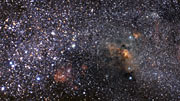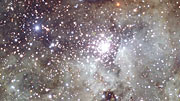Comunicato Stampa
Le stelle dietro il sipario
03 Febbraio 2010
ESO rende pubblica una magnifica immagine, ottenuta dal VLT, di NGC 3603, un gigantesco vivaio stellare in cui nascono in continuazione nuove stelle. All'interno di questa pittoresca nebulosa si trova uno degli ammassi di stelle giovani e massicce più luminosi e compatti della Via Lattea. Quest’oggetto risulta quindi utile come un ottimo analogo "locale" delle regioni di formazione stellare osservate in altre galassie. L’ammasso ospita anche la stella più massiccia finora "pesata".
NGC 3603 è una regione di intensa formazione stellare: una fabbrica cosmica dove, a ritmo frenetico, si producono stelle a partire dalle estese nubi di gas e polvere della nebulosa. Situata a 22.000 anni luce di distanza dal Sole, si tratta della più vicina regione di questo tipo nota nella nostra galassia, e fornisce quindi agli astronomi una sorta di laboratorio locale per lo studio dei processi di intensa formazione stellare, molto comuni in altre galassie, ma difficili da osservare in dettaglio a causa della loro grande distanza da noi.
La nebulosa deve la sua forma alla luce intensa e ai forti venti provenienti da giovani stelle massicce, che sollevano il sipario di gas e nubi rivelando una moltitudine di soli brillanti. L'ammasso stellare situato al centro di NGC 3603 ospita migliaia di stelle di tutti i tipi (eso9946): la maggior parte di esse hanno masse simili o inferiori a quella del nostro Sole, ma le più spettacolari sono alcune stelle molto massicce, prossime al termine della loro vita. Svariate stelle supergiganti blu si affollano in un volume inferiore a un anno luce cubico, insieme a tre cosiddette stelle Wolf-Rayet, ovvero stelle estremamente luminose e massicce che stanno espellendo grandi quantità di materiale prima di terminare la loro vita in gloriose esplosioni note come supernovae. Utilizzando un'altra serie di osservazioni effettuate recentemente con lo strumento SINFONI al Very Large Telescope (VLT) dell'ESO, gli astronomi hanno confermato che una di queste stelle ha una massa pari a circa 120 volte quella del nostro Sole, distinguendosi così come la stella più massiccia finora scoperta nella Via Lattea [1].
Le nubi di NGC 3603 ci forniscono il ritratto di una famiglia di stelle che si trovano in diverse fasi della loro vita, a partire da strutture gassose che stanno ancora trasformandosi in stelle, passando per stelle appena nate e stelle adulte, fino a stelle che si avvicinano alla fine della loro vita. Tutte queste stelle hanno all'incirca la stessa età, un milione di anni, un batter d'occhio rispetto ai cinque miliardi di anni d'età del nostro Sole e del Sistema Solare. Il fatto che alcune delle stelle abbiano appena iniziato la loro vita, mentre altre stanno già morendo, è dovuto alla loro straordinaria varietà di masse: le stelle di massa elevata, infatti, sono molto luminose e calde, e quindi, durante la loro esistenza, bruciano molto più in fretta rispetto alle loro controparti più fioche e fredde.
L'immagine che viene rilasciata oggi, ottenuta con lo strumento FORS montato sul VLT a Cerro Paranal, in Cile, ritrae un vasto campo attorno all'ammasso stellare, rivelando la ricca trama delle nubi di gas e polvere che lo circondano.
Note
[1] La stella, NGC 3603-A1, è in effetti un sistema di due stelle che orbitano l'una intorno all'altra in 3.77 giorni, eclissandosi a vicenda. La stella più massiccia delle due ha una massa stimata pari a 116 volte quella del Sole, mentre la sua compagna ha una massa pari a 89 volte la massa solare.
Ulteriori Informazioni
L’ESO (European Southern Observatory) è la principale organizzazione intergovernativa di Astronomia in Europa e l’osservatorio astronomico più produttivo al mondo. È sostenuto da 14 paesi: Austria, Belgio, Repubblica Ceca, Danimarca, Finlandia, Francia, Germania, Italia, Olanda, Portogallo, Spagna, Svezia, Svizzera e Gran Bretagna. L’ESO mette in atto un ambizioso programma che si concentra sulla progettazione, costruzione e gestione di potenti strutture astronomiche da terra che consentano agli astronomi di fare importanti scoperte scientifiche. L’ESO ha anche un ruolo preminente nel promuovere e organizzare cooperazione nella ricerca astronomica. L’ ESO gestisce tre siti unici di livello mondiale in Cile: La Silla, Paranal e Chajnantor. A Paranal, l’ESO gestisce il Very Large Telescope, l’osservatorio astronomico nella banda visibile più d’avanguardia al mondo. L’ESO è il partner europeo di un telescopio astronomico rivoluzionario, ALMA, il più grande progetto astronomico esistente. L’ESO sta pianificando al momento un Telescopio Europeo Estremamente Grande ottico/vicino-infrarosso di 42 metri, l’E-ELT, che diventerà “il più grande occhio del mondo rivolto al cielo”.
Contatti
Henri Boffin
ESO
Garching, Germany
Tel.: +49 89 3200 6222
E-mail: hboffin@eso.org
Joerg Gasser (press contact Svizzera)
Rete di divulgazione scientifica dell'ESO
E-mail: eson-switzerland@eso.org
Sul Comunicato Stampa
| Comunicato Stampa N": | eso1005it-ch |
| Nome: | NGC 3603 |
| Tipo: | Milky Way : Star : Grouping : Cluster : Open Milky Way : Nebula : Type : Star Formation |
| Facility: | Very Large Telescope |
| Instruments: | FORS1 |
Our use of Cookies
We use cookies that are essential for accessing our websites and using our services. We also use cookies to analyse, measure and improve our websites’ performance, to enable content sharing via social media and to display media content hosted on third-party platforms.
ESO Cookies Policy
The European Organisation for Astronomical Research in the Southern Hemisphere (ESO) is the pre-eminent intergovernmental science and technology organisation in astronomy. It carries out an ambitious programme focused on the design, construction and operation of powerful ground-based observing facilities for astronomy.
This Cookies Policy is intended to provide clarity by outlining the cookies used on the ESO public websites, their functions, the options you have for controlling them, and the ways you can contact us for additional details.
What are cookies?
Cookies are small pieces of data stored on your device by websites you visit. They serve various purposes, such as remembering login credentials and preferences and enhance your browsing experience.
Categories of cookies we use
Essential cookies (always active): These cookies are strictly necessary for the proper functioning of our website. Without these cookies, the website cannot operate correctly, and certain services, such as logging in or accessing secure areas, may not be available; because they are essential for the website’s operation, they cannot be disabled.
Functional Cookies: These cookies enhance your browsing experience by enabling additional features and personalization, such as remembering your preferences and settings. While not strictly necessary for the website to function, they improve usability and convenience; these cookies are only placed if you provide your consent.
Analytics cookies: These cookies collect information about how visitors interact with our website, such as which pages are visited most often and how users navigate the site. This data helps us improve website performance, optimize content, and enhance the user experience; these cookies are only placed if you provide your consent. We use the following analytics cookies.
Matomo Cookies:
This website uses Matomo (formerly Piwik), an open source software which enables the statistical analysis of website visits. Matomo uses cookies (text files) which are saved on your computer and which allow us to analyze how you use our website. The website user information generated by the cookies will only be saved on the servers of our IT Department. We use this information to analyze www.eso.org visits and to prepare reports on website activities. These data will not be disclosed to third parties.
On behalf of ESO, Matomo will use this information for the purpose of evaluating your use of the website, compiling reports on website activity and providing other services relating to website activity and internet usage.
Matomo cookies settings:
Additional Third-party cookies on ESO websites: some of our pages display content from external providers, e.g. YouTube.
Such third-party services are outside of ESO control and may, at any time, change their terms of service, use of cookies, etc.
YouTube: Some videos on the ESO website are embedded from ESO’s official YouTube channel. We have enabled YouTube’s privacy-enhanced mode, meaning that no cookies are set unless the user actively clicks on the video to play it. Additionally, in this mode, YouTube does not store any personally identifiable cookie data for embedded video playbacks. For more details, please refer to YouTube’s embedding videos information page.
Cookies can also be classified based on the following elements.
Regarding the domain, there are:
- First-party cookies, set by the website you are currently visiting. They are stored by the same domain that you are browsing and are used to enhance your experience on that site;
- Third-party cookies, set by a domain other than the one you are currently visiting.
As for their duration, cookies can be:
- Browser-session cookies, which are deleted when the user closes the browser;
- Stored cookies, which stay on the user's device for a predetermined period of time.
How to manage cookies
Cookie settings: You can modify your cookie choices for the ESO webpages at any time by clicking on the link Cookie settings at the bottom of any page.
In your browser: If you wish to delete cookies or instruct your browser to delete or block cookies by default, please visit the help pages of your browser:
Please be aware that if you delete or decline cookies, certain functionalities of our website may be not be available and your browsing experience may be affected.
You can set most browsers to prevent any cookies being placed on your device, but you may then have to manually adjust some preferences every time you visit a site/page. And some services and functionalities may not work properly at all (e.g. profile logging-in, shop check out).
Updates to the ESO Cookies Policy
The ESO Cookies Policy may be subject to future updates, which will be made available on this page.
Additional information
For any queries related to cookies, please contact: pdprATesoDOTorg.
As ESO public webpages are managed by our Department of Communication, your questions will be dealt with the support of the said Department.




